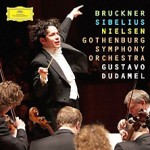It’s appropriate that since his appointment as music director of the Gothenburg Symphony Orchestra Gustavo Dudamel would present works by Scandinavian composers. Reportedly he was unfamiliar with this music, but adapted quickly. The Nielsen Symphony No. 5 gives a sense of this–there’s a feeling of freshness in Dudamel’s approach, and all the while there’s no doubt he has the work firmly in his grasp. The long first movement begins in an air of anticipation, then proceeds purposefully. However, as is often the case, the climactic snare drum vs. orchestra passage suggests little sense of struggle (the classic Horenstein recording evokes great drama and excitement here). The big second movement captivates with its swirling kinetic energy.
The Nielsen Fourth, however, could have used a bit more study. Dudamel projects the requisite energy at the start of the first movement, but things get murky come the development, where the conductor fails to delineate the complex contrapuntal lines. In fact, it’s the sharp edges that are missing from this performance. The Poco adagio’s timpani strikes don’t project, robbing the music of its punch. Ditto for the finale, where the supposedly dueling timpani sound more like two pals at the bowling lanes.
Dudamel does capture the unique sound-world of Sibelius in the Symphony No. 2, although more than a little credit must go to the Gothenburg musicians, who have a long tradition with this music. The conductor leads a smoothly flowing, dynamically alert rendition that, while not offering any unique insights, impresses with its vigor and finesse.
The Bruckner Ninth is often thought to be old man’s music best left to wizened interpreters (of which the masterful Gunter Wand is an exemplar). However, as Zubin Mehta did before him, Dudamel proves that a younger man can probe the work’s profound depths as well as enliven it with youthful fire.
From the first movement on it’s clear that Dudamel not only has the measure of the piece’s massive scale but also a strong sense of its structure, all the while rendering the music’s unique tonal colors with admirable sensitivity. The scherzo is at once caustic and clumsy, while the Adagio is radiant and moving, with a gripping climax. A fine Bruckner Ninth, along with the Nielsen Fifth, are the real draws to this set. The recordings were made live, with the attendant acoustic dampening, but offer excellent clarity and dynamic range. However, beware the download version as it suffers from low bit-rate distortion resulting in a fluttering, breaking-apart sound quality–especially when using headphones (irrespective of vendor).
































